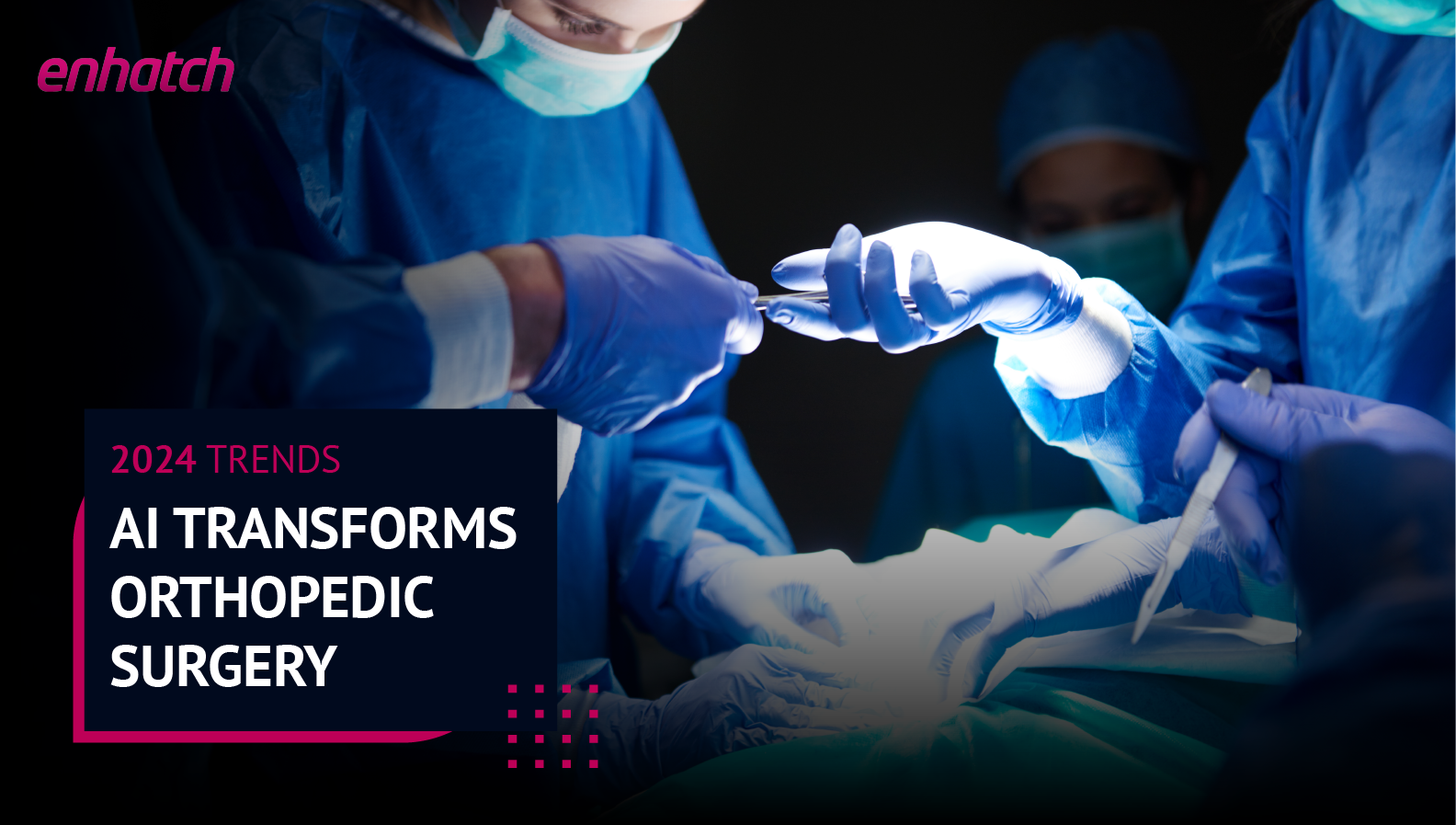2024 Trends: AI Transforms Orthopedic Surgical Case Planning

As we navigate through the 21st century, Artificial Intelligence (AI) stands at the forefront of transforming healthcare, with orthopedic surgery being a prime example.
The AI market in healthcare, currently valued at $14.6 billion in 2023, is predicted to surge to an astounding $102.7 billion in just five years. This represents a massive leap!
This groundbreaking technology is being used to improve every part of the continuum of care — from elevating patient outcomes to addressing deep-rooted administrative inefficiencies.
Let's delve into how AI is revolutionizing orthopedic surgery, especially in preoperative planning for surgeons, care facilities, and medical device companies.
AI in Fracture Diagnostics
Artificial Intelligence is becoming a valuable ally in the field of orthopedics, particularly in fracture diagnostics. While imaging technology has improved significantly, some fractures continue to be misdiagnosed. Examples include:
- Subtle ankle fractures that present as sprains
- Early stress fractures that are hard to identify on X-rays
- Signs of certain cervical fractures can be non-specific, making them hard to diagnose
Through advanced image analysis, AI technology has demonstrated remarkable accuracy, with reported rates reaching up to 98% in identifying fractures – even those that prove challenging for traditional diagnostic methods.
AI for osteoarthritis (OA) classification
AI is also proving invaluable in classifying osteoarthritis using X-rays and detecting fractures related to osteoporosis. A study in 2021 using deep learning demonstrated its effectiveness with over 97% accuracy in knee osteoarthritis classification.
So, integrating AI in fracture diagnostics not only enhances the speed of analysis but also helps improve the overall understanding of bone health.
Companies to watch in this space: Gleamer (BoneView), Imagen Technologies, and Aidoc Medical (Briefcase).
3D digital templating with AI
Surgical planning is getting a boost from AI, especially in orthopedics. The traditional manual method of measuring X-rays or CT images is time-consuming, ineffective, and hard to sustain in today’s environment because:
-
The demand for orthopedic surgery is extremely high, but there aren't sufficient orthopedic surgeons.
-
Surgeons are dealing with increasing caseloads but have leaner surgical teams to work with, leading to surgeon burnout.
-
Surgeons often have to work with ever-changing surgical teams, making it challenging to keep their surgical preferences in mind when templating. For example, surgeons may not have the time to train new team members on their choice of surgical approaches, techniques, implant types based on patient wear patterns, and much more.
So, dedicating the same amount of time to each patient's imaging data has become exceedingly challenging. Surgeons need a way to template accurately and efficiently.
With AI, surgeons can now perform 3D templating directly from standard X-rays to help improve accuracy in surgical planning and save time.
This type of surgical accuracy, coupled with efficiency, is super important right now, especially as total hip arthroplasty (THA) and total knee arthroplasty (TKA) surgeries are moving to ambulatory surgery centers (ASCs) — where they are now outpatient procedures.
In a no-frills environment like in ASCs, surgeons operate under extremely tight schedules and lean teams, making it more important to have fast, accurate templating for each surgery.
Companies to watch in this space: Enhatch, PeekMed.
Surgical planning for Patient-Specific Implants
Patient-specific implants—to an outsider, the term conjures images of personalized solutions, tailor-made to match each patient’s unique anatomies and needs. Ideally, surgeons would also choose custom-made guides to help them make accurate surgical cuts while greatly improving OR efficiency. Additionally, if executed well, the idea is a win-win for hospitals, ASCs, and medical device companies looking to reduce inventory, sterilization, and logistics-related costs. Think about it—no more instrument and implant trays stacked to the ceiling in the OR, fewer warehouses, and no wasted spend.
But here's the catch: 3D-printed implants aren't the norm because the process is full of hurdles, including:
- Patients do not like getting CT scans in addition to X-rays for THAs and TKAs: Orthopedic patients are asked to get CT scans along with their usual X-rays as part of the patient-specific device process. This process adds inconvenience to the patient, more exposure to radiation, time, and significant costs to the growing healthcare burden.
- Getting approved patient-specific surgical plans is challenging: The end-to-end process for personalized medical devices can be highly inefficient behind the scenes. Often, each case involves many follow-up emails, text messages, and calls flying back and forth between surgeons, engineers, sales reps, and medical device logistics teams. Unfortunately, such a process can make it easy for valuable information to fall through the cracks and lengthen the approval process.
Enter AI to streamline the surgical planning process for patient-specific implants.
AI platforms that can generate 3D anatomic models directly from X-rays are changing the game. Surgeons can also review and approve templating recommendations online and communicate with engineers, sales reps, and anyone else whose input is relevant. Managing everything on one platform makes life easier, letting medical device leaders plan surgeries, track progress, and more.
The result? This can streamline the overall process of getting 3D-printed implants and instruments into a surgeon’s hands. Also, without having to maintain large product inventory, even small to mid-sized medical device companies can innovate and bring their patient-specific designs to market with ease.
Companies to watch in this space: Enhatch, Materialise, Synopsys, Axial 3D.
Final thoughts/key takeaways
- AI is reshaping the future of orthopedic surgery and healthcare. The use of AI in healthcare is estimated to grow rapidly over the next five years, enhancing patient outcomes and addressing administrative inefficiencies throughout the continuum of care.
- In orthopedics, AI is transforming the world of diagnostics and preoperative planning.
- Companies making strides in this space include Enhatch, Gleamer, Imagen Technologies, and Aidoc Medical, PeekMed, and Synopsys.
- AI platforms can now generate 3D anatomic models directly from X-rays, greatly improving the accuracy and efficiency of patient-specific implants.
Sources
-
Artificial intelligence (AI) in healthcare market Size, growth report analysis 2031. (2023, January). Retrieved December 13, 2023, from MarketsandMarkets website: Visit page.
-
Mahum, R., Rehman, S. U., Meraj, T., Rauf, H. T., Irtaza, A., El-Sherbeeny, A. M., & El-Meligy, M. A. (2021). A novel hybrid approach based on deep CNN features to detect Knee Osteoarthritis. Sensors (Basel, Switzerland), 21(18), 6189. doi:10.3390/s21186189
-
Pranata, Y. D., Wang, K.-C., Wang, J.-C., Idram, I., Lai, J.-Y., Liu, J.-W., & Hsieh, I.-H. (2019). Deep learning and SURF for automated classification and detection of calcaneus fractures in CT images. Computer Methods and Programs in Biomedicine, 171, 27–37. doi:10.1016/j.cmpb.2019.02.006.



